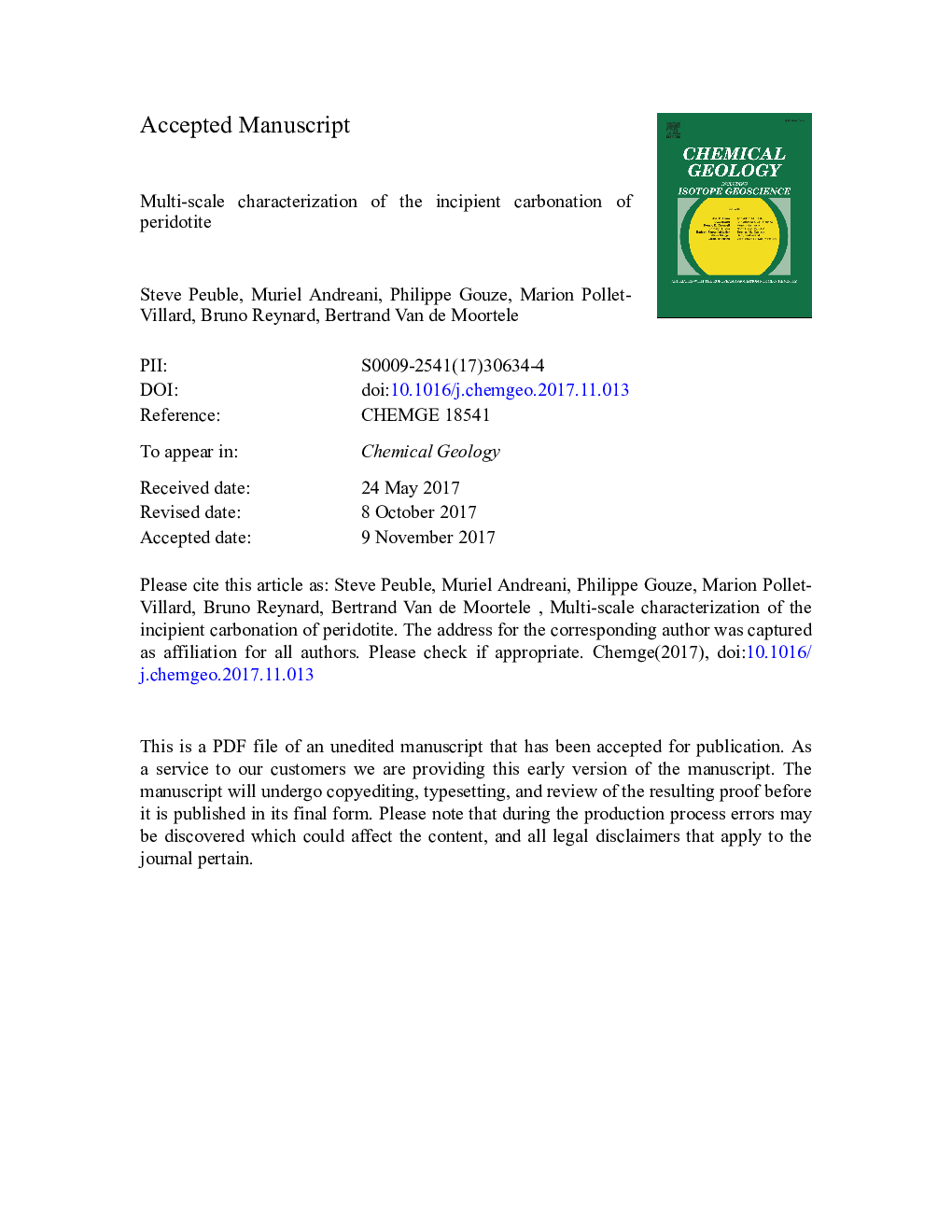| کد مقاله | کد نشریه | سال انتشار | مقاله انگلیسی | نسخه تمام متن |
|---|---|---|---|---|
| 8910453 | 1637498 | 2018 | 40 صفحه PDF | دانلود رایگان |
عنوان انگلیسی مقاله ISI
Multi-scale characterization of the incipient carbonation of peridotite
ترجمه فارسی عنوان
خصوصیات چند ضلعی کربنات اولیه پریدوتیت
دانلود مقاله + سفارش ترجمه
دانلود مقاله ISI انگلیسی
رایگان برای ایرانیان
کلمات کلیدی
موضوعات مرتبط
مهندسی و علوم پایه
علوم زمین و سیارات
ژئوشیمی و پترولوژی
چکیده انگلیسی
Carbonation of peridotite is a widespread process in nature, with emerging societal and environmental implications through geological storage of CO2. We studied the micro- and nano-scale structures associated with the carbonation of peridotite pervaded by a CO2-rich water and the induced changes of its hydrodynamic properties. Focused ion beam (FIB) nanotomography was coupled with scanning electron microscopy (SEM) and transmission electron microscopy (TEM) observations. An experimental sample of dunite core percolated by a CO2-rich fluid (pCO2 = 11 MPa) at 160 °C was compared with a naturally carbonated sample from the Atlantic Ridge (Exp. IODP 304). Results of the 8-days percolation experiment show continuous alteration of olivine into magnesite locally associated with a poorly crystalline serpentine-type mineral referred to as proto-serpentine. The experiment is also characterized by an overall decrease in rock porosity (from 7.7 to 6.4%) and permeability (from 8.5 Ã 10â 16 to 1.7 Ã 10â 16 m2). The primary inter-granular porosity (1 to 10 μm) is progressively filled with magnesite, leading to the overall decrease of permeability. At the same time, a secondary small-scale porosity (10 nm to 1 μm) is created at the tip of the dissolution features along the (010) cleavage planes of olivine grains. Carbonate crystals grow within these etch-pit structures behind the dissolution front. Dissolution and precipitation occur at a relative rate that maintains the secondary porosity over the timescale of the experiment (i.e. carbonate growth has to be the slowest one). This process is interpreted as an interface coupled dissolution-precipitation mechanism of olivine carbonation. Proto-serpentine is only formed in highly reduced flow areas, such as small olivine etch-pits (10 to 500 nm wide), which are more isolated from CO2 input. SEM-FIB analyses show the 3D preferential orientation of the dissolution-precipitation planes within a given olivine grain. It suggests the formation of lateral connections between the etch-pits (infra-micrometric “channels”) providing access to reactants and removing reaction products at the reaction sites. The experimental results show that olivine dissolution and magnesite precipitation converge to a quasi-steady state resulting in a constant carbonation rate controlled by reaction kinetics and not by mass transfer for this flow regime. The system self-regulates, independently of the porosity change at least during this incipient stage of olivine carbonation. Similar textures are observed in natural samples collected at 170 m-depth in the vicinity of veinlets driving late fluids down into the cooling oceanic lithosphere. This suggests that similar mechanisms are active in nature and can play an important role in the late, low temperature alteration stages of fractured peridotite. These results also highlight the critical role of nm-scale spatial arrangement of dissolution and precipitation features on mass transfers and on the sustainability of olivine carbonation through coupled dissolution-precipitation processes.
ناشر
Database: Elsevier - ScienceDirect (ساینس دایرکت)
Journal: Chemical Geology - Volume 476, 5 January 2018, Pages 150-160
Journal: Chemical Geology - Volume 476, 5 January 2018, Pages 150-160
نویسندگان
Steve Peuble, Muriel Andreani, Philippe Gouze, Marion Pollet-Villard, Bruno Reynard, Bertrand Van de Moortele,
